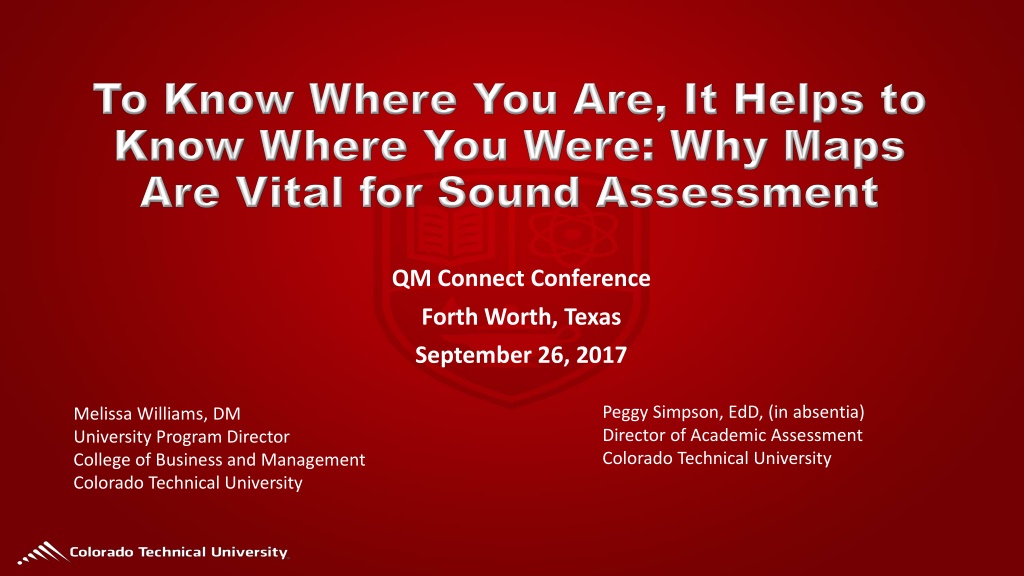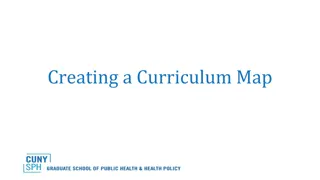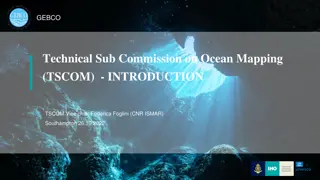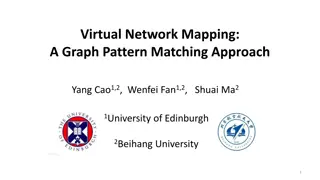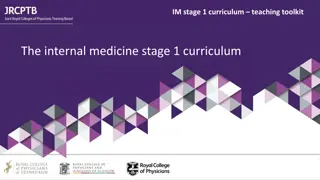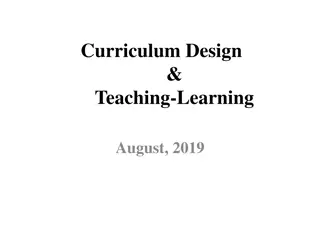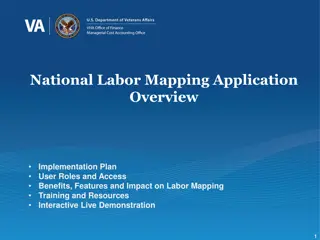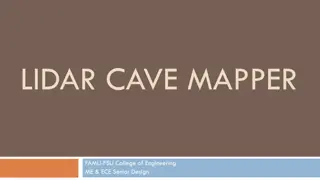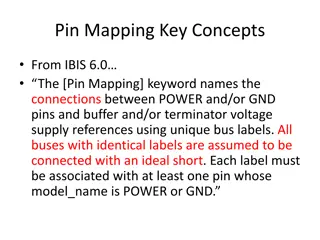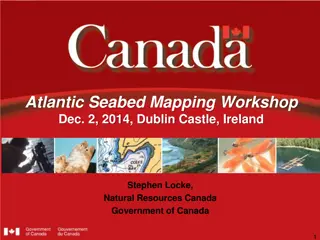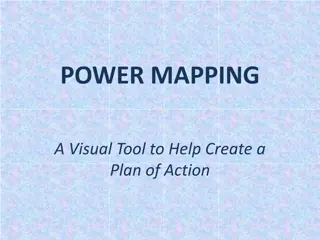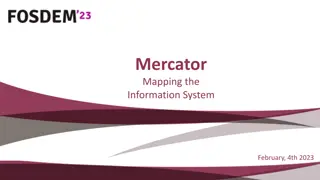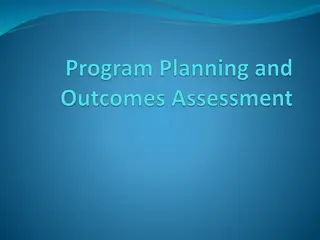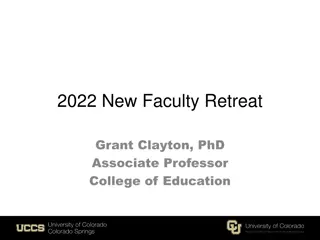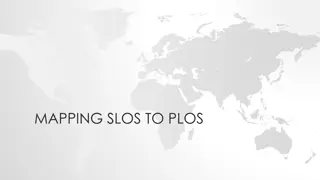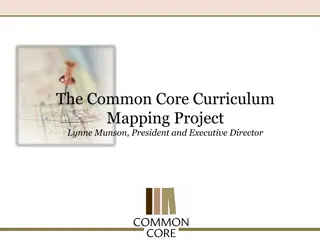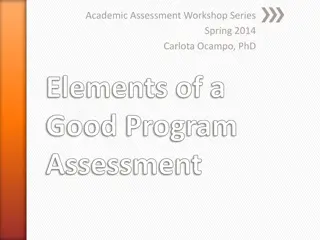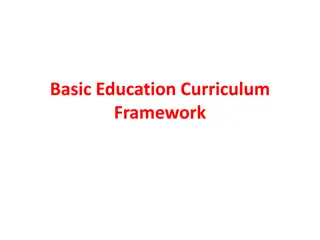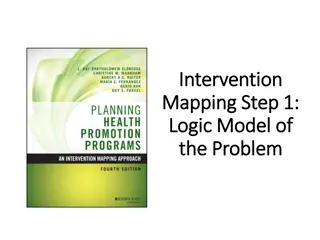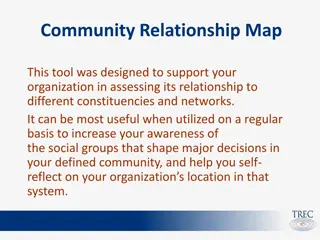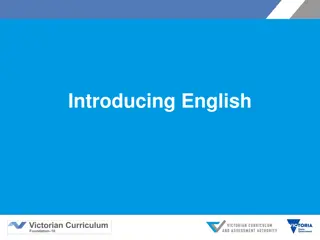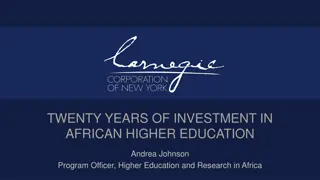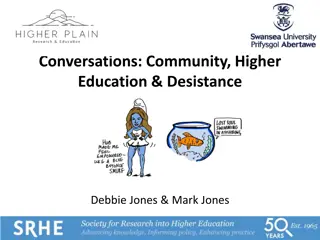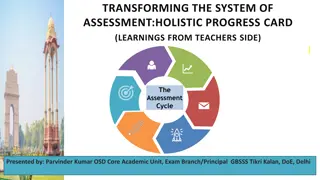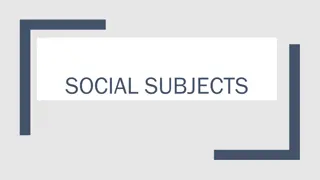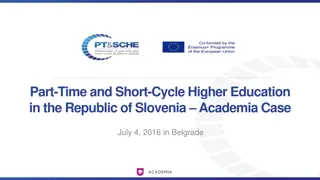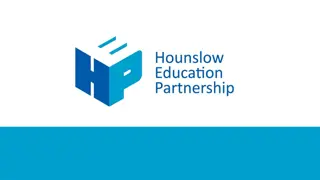Assessment and Curriculum Mapping in Higher Education
This presentation at the QM Connect Conference delves into the relationship between curriculum mapping and assessment for ensuring quality program content. Featuring speakers from Colorado Technical University, the session explores the university's mission, the College of Business and Management's concentrations, and program outcomes. It focuses on industry relevance, academic standards, program accreditation, and assessment methods in higher education. The presentation also covers specific program outcomes for the BSPM (Bachelor of Science in Project Management) program, highlighting leadership styles, global marketplace impact, and project alignment with organizational strategy.
Download Presentation

Please find below an Image/Link to download the presentation.
The content on the website is provided AS IS for your information and personal use only. It may not be sold, licensed, or shared on other websites without obtaining consent from the author. Download presentation by click this link. If you encounter any issues during the download, it is possible that the publisher has removed the file from their server.
E N D
Presentation Transcript
QM Connect Conference Forth Worth, Texas September 26, 2017 Peggy Simpson, EdD, (in absentia) Director of Academic Assessment Colorado Technical University Melissa Williams, DM University Program Director College of Business and Management Colorado Technical University
Objectives Upon completion of this session, participants will be able to: Describe the relationship between curriculum mapping and assessment as it applies to quality assurance of program content
University Mission CTU Overview Configuring the path: Outcomes Program Concentration General Education Standards Programmatic Accreditation Industry Mapping Tool Development Mapping Tool Demonstration Assessment Strategic Considerations Identifying Assessment Methods Colorado Technical University's mission is to provide industry relevant higher education to a diverse student population through innovative technology and experienced faculty, enabling the pursuit of personal and professional goals.
College of Business and Management 20+ concentrations/ programs Degree Levels Associates Bachelors Masters Doctoral (DM, DBA, DCS) CTU maintains ~23,000 students (campuses & online) CTU Overview Configuring the path: Outcomes Program Concentration General Education Standards Programmatic Accreditation Industry Mapping Tool Development Mapping Tool Demonstration Assessment Strategic Considerations Identifying Assessment Methods
CTU Overview CTU Mission Configuring the path: Outcomes Program Concentration General Education Standards Programmatic Accreditation Industry Mapping Tool Development Mapping Tool Demonstration Assessment Strategic Considerations Identifying Assessment Methods Accrediting Body Standards CoBM Mission Assessment Industry Standards Undergraduate Outcomes Program Outcomes
BSPM Program Outcomes Assess personal leadership style and adapt to needs of situations, employees, and co-workers. Evaluate the impact that a global marketplace and economy has on project management practices, human resources, and strategic decision making. Discover how project managers align organizational strategy with leadership and stakeholder needs to satisfy project requirements. Apply appropriate PMBOK Guide knowledge areas to project situations and work environments. Define a project, project management, and type of project structures, project life cycle phases, knowledge areas, and process. Explain management and integration of organizational programs and project portfolios. Identify tools, principles, and techniques of continuous process improvement. Create and implement a proactive risk management and quality plan and develop contingency plans. Analyze project scope and identify project key tasks and stakeholders; manage scope changes CTU Overview Configuring the path: Outcomes Program Concentration General Education Standards Programmatic Accreditation Industry Mapping Tool Development Mapping Tool Demonstration Assessment Strategic Considerations Identifying Assessment Methods
Undergraduate General Education Outcomes CTU Overview Upon completion of their undergraduate degree at Colorado Technical University, graduates will have acquired a range of critical thinking skills allowing them to: Employ skills, habits, and practices that inspire personal improvement and professional development Communicate effectively by responding to and composing written documents and presenting to various audiences Computequantitative and qualitative information using appropriate methods of analysis and examine how the sciences impact the global community Employ appropriate technology tools, programs, and information to execute decision-making and solve problems Explorecultural implications to encourage effective interactions with those who differ in beliefs, behaviors, values, or views Demonstrate ethical decision-making as a student and a professional Configuring the path: Outcomes Program Concentration General Education Standards Programmatic Accreditation Industry Mapping Tool Development Mapping Tool Demonstration Assessment Strategic Considerations Identifying Assessment Methods
Accreditation Standards Professional Component A. Accounting B. Computer information applications C. Quantitative methods of analysis D. Principles of economics E. Business in society - the international environment, legal/political environment, and ethical business behavior F. Marketing G. Entrepreneurship/free enterprise H. Finance I. Management Business Major Component Areas of specialization that build and/or organize knowledge dealing with specific aspects of business and its environment with interactions between these elements The ability to increase knowledge, understanding, and skills in prerequisite and concurrent courses and to integrate and apply these gains to subsequent business courses in the major The depth and breadth of knowledge, understanding, and skills in the content area of specialization beyond that which is in the professional component Application of knowledge that is utilized by internships, field experiences and cooperative education, simulations, and/or similar activities which enhance the professional education experience ACBSP CTU Overview Configuring the path: Outcomes Program Concentration General Education Standards Programmatic Accreditation Industry Mapping Tool Development Mapping Tool Demonstration Assessment Strategic Considerations Identifying Assessment Methods
Project Management Institute-Global Accreditation Center CTU Overview Configuring the path: Outcomes Program Concentration General Education Standards Programmatic Accreditation Industry Mapping Tool Development Mapping Tool Demonstration Assessment Strategic Considerations Identifying Assessment Methods 1. Project Selection and Initiation 2. Project Planning 3. Project Execution and Control 4. Project Close 5. Ethics and Professional Responsibility 6. Talent Triangle
Mapping Components CTU Overview Bloom s Leveling Course Categorization Program Outcomes Concentration Outcomes GenEd Outcomes Professional Standards Accreditation Standards Keeping Count Configuring the path: Outcomes Program Concentration General Education Standards Programmatic Accreditation Industry Mapping Tool Development Mapping Tool Demonstration Assessment Strategic Considerations Identifying Assessment Methods
CTU Curriculum Mapping Components Governance/Approval Tracking Keeping Count Degree Levelling Tool Program:Degree Degree Total Outcomes University Learning Outcomes Name/Concentration Program Outcomes Prof. Standards Accred. Standards Blooms Taxonomy Knowledge, Comprehension Level K University Dean Professional Standards Source derived from: Application, Analysis A Accreditation Standards Source derived from: Synthesis, Evaluation S Completed by: Approved by: Approval Date: Version: Submission Date: Programmatic Outcomes Category Competency (Sub-Competency) Professional Standards Project Management Institute- Global Accreditation Center Category Competency (Sub-Competency) University (GenEd) Learning Outcomes Category Competency (Sub-Competency) Accreditation Standards ACBSP Category Competency (Sub-Competency)
Bachelor of Science in Project Management Degree Total Outcomes 230 University Learning Outcomes 47 Prof. Standard s 74 Program Outcomes 29 Accred. Standards 80 Blooms Taxonomy Level Knowledge, Comprehension K Application, Analysis A 505 56 86 238 125 Synthesis, Evaluation S 52 19 6 19 8
BSPM Bloom's Leveling Bloom's Leveling GenEd BSPM Program & Program & GenEd 6.61% 29.22% 64.17% K A S
Assessment Planning CTU Overview Configuring the path: Outcomes Program Concentration General Education Standards Programmatic Accreditation Industry Mapping Tool Development Mapping Tool Demonstration Assessment Strategic Considerations Identifying Assessment Methods Identify Points of Assessment throughout program Identify Assessment measures Direct Measures Indirect Measures Supportive Measures
Guide: Sample Types of Assessment Evidence Guide: Sample Types of Assessment Evidence Direct Evidence Indirect Evidence Supportive Evidence Student Work Alumni, Employer, and Student Surveys Instructor/Faculty Surveys Enrollment Trends/Retention and Transfer Info Time to Degree Project/Activity from Capstone Experience Portfolio Standardized Tests National Licensure/ Certification/ Professional Exam Results Essay Questions with Blind Scoring Exit Interviews Focus Groups Graduate Follow-up Studies SAT, ACT, GRE, GMAT GPA Graduation Rates/ Transfer Rates External or Peer Review Placement Data (Job/Graduate School) Student Publication Curriculum Analysis Reflection Papers Qualitative (Internal/External) Juried Reviews of Comprehensive Projects External Evaluation of Performance during Internship Experiences Oral Presentations Syllabus Analysis Faculty/Student Ratios Diversity of Student Body 16
Constituent Consults University Academic Assessment Committee College Academic Leadership General Education Academic Leadership Provost Council Considerations Mission Driven Industry Relevant Programmatic Accreditation (when applicable) CTU Overview Configuring the path: Outcomes Program Concentration General Education Standards Programmatic Accreditation Industry Mapping Tool Development Mapping Tool Demonstration Assessment Strategic Considerations Identifying Assessment Methods
LMSTitles ProgramCompetencies NoAssignment Unacceptable Minimal Competent Effective Mastery ProgramCompetencies demonstratedin assignment LMSHeaders U 0 1 2 3 4 Can identify various leadership styles with some personal application and adaptability for various situations and personnel. Can demonstrate and compare various personal leadership styles dependent upon situation and personnel. Assess personal leadership style and adapt to needs of situations, employees, and co workers. There is no student submission of assignment. No demonstration of competency is evident within theassignment. Identifies general leadership styles while minimal personalapplicationto adaptin a generalsense. showing Not only identifies and employs various leadership styles, but also develops various strategies for consideration. PERSONAL LEADERSTYLE Common Assessment Rubric Program/Concentration: BS-PM Artifact: IP5 Evaluate the impact that a global marketplace and economy has on project management (PM) practices, human resources, and strategic decisionmaking. Evaluates and applies concepts and principles through effective demonstration of global influence on strategicdecision making. There is no student submission of assignment. No demonstration of competency is evident within theassignment. Discusses basic concepts toward making decisions for project management within a globalenvironment. Identifies and illustrates the global impact on PM practices, human resources, and strategic decision making. Formulates a general decision with some application of global concepts andprinciples. IMPACT GLOBALMARKET Outlines numerous examples of how project managers align organizational strategy with leadership and stakeholder needs to satisfy project needs. Discover how project managers align organizational strategy with leadership and stakeholder needs to satisfy project requirements. Demonstrates awareness of a project manager s role in aligning organizational strategy with leadership and stakeholder needs. There is no student submission of assignment. No demonstration of competency is evident within theassignment. Explains the basic role of project managers within aligning organizational strategy toward project requirements. Insightfully discusses evidence of effective project manager assistance within organizationalstrategy. ALIGN ORGSTRATEGY Forms a vague/ weak application of appropriate PMBOK Guide knowledge areas to project situations and work environments. Formulates a precise use of appropriate PMBOK Guide knowledge areas to project situations and work environments. Formulates, with justification, clear and appropriate application of PMBOK Guide knowledge areas to project situations and workenvironments. Course Number: PM430 Course Name: Project Management Capstone Apply appropriate PMBOK Guide knowledge areas to project situations and work environments. There is no student submission of assignment. No demonstration of competency is evident within theassignment. Can describe in general terms, the PMBOK Guide knowledge areas to project situations and work environments. APPLY PMBOKGUIDE Define a project, project management, and type of project structures, project life cycle phases, knowledge areas, and process. There is no student submission of assignment. No demonstration of competency is evident within theassignment. Generally describes a project, PM, type of project structures, project life cycle phases, knowledge areas, and process. Explains and connects the various terminology specific to PM as outlined in theobjective. Formulates a clear and precise use of the terminology specific to PM as outlined in the objective. Not only identifies and explains terminology discussed, but provides new information for consideration. DEFINEPM Explain management and integration of organizational programs and project portfolios. There is no student submission of assignment. No demonstration of competency is evident within theassignment. Identifies basic management and integration of organizational programs and projectportfolios. Identifies some of the most important regarding management and integration, but does not apply them. dynamics Explains management and integration of organizational programs and projectportfolios. Adapts and evaluates understanding of various worldviews and individual experiences. MANAGE ORG PROGRAMS Identify tools, principles, and techniques of continuous process improvement. There is no student submission of assignment. No demonstration of competency is evident within theassignment. Recognizes various tools, principles, and techniques of continuous process improvement. Provides a general application of tools, principles, and techniques of continuous processimprovement. Differentiates between the tools, principles, and techniques of continuous process improvement. Assesses the tools, principles, and techniques of continuous process improvement. CONT.IMPROVEMENT Creates basic proactive risk management and quality plan and develop contingency plans; though the plans are missing some details. Creates and implements a proactive risk management and quality plan and develop contingency plans, with clarity and efficiency. Create management and quality plan contingency plans. and implement a proactive and develop risk There is no student submission of assignment. No demonstration of competency is evident within theassignment. Identifies some/ most elements of a proactive risk management and quality plan and develop contingency plans. Creates and implements a proactive risk management and quality plan and develop contingencyplans. PROACTIVEPLANNING Explains and identifies some of the most important project scope and key tasks and stakeholders; shows ability to manage scope changes. Analyze project scope and identify project key tasks and stakeholders; manage scopechanges. There is no student submission of assignment. No demonstration of competency is evident within theassignment. General identification of project scope and key tasks and stakeholders; with limited ability to manage scope changes. Analyzes project scope and identifies project key tasks and stakeholders; manages scope changes. Analyzes and assesses project scope and identifies project key tasks and stakeholders; manages scope changes. ANALYZE/MANAGESCOPE Applies some of the most important skills, habits, and practices that inspire personal improvement and professional development. Selects appropriate skills, habits, and practices that inspire personal improvement and professional development. Creates strategies toward stronger use of skills, habits, and practices that inspire personal improvement and professionaldevelopment. Employ skills, habits, and practices that inspire personal improvement development. There is no student submission of assignment. No demonstration of competency is evident within theassignment. Identifies various skills, habits, and practices toward personal improvement and professional development. and professional PROF.DEVELOPMENT Communicate effectively by responding to and composing written documents and presenting to variousaudiences. Applies effective communication strategies when responding to and composing documents and presenting to various audiences. There is no student submission of assignment. No demonstration of competency is evident within theassignment. Identifies a clear focus on discussion throughout most all written documentation. Composes clear and effective documentation and presentation materials for varied audiences. Able to summarize main points and positions within various documents and presentations. COMMUNICATION Employ appropriate technology tools, programs, and information to execute decision making and solve problems. Shows ability to employ appropriate technology tools, programs, and information to execute decision making and solveproblems. Selects and uses the appropriate technology tools, programs, and information to execute decision making and solveproblems. Prepares well planned material using the appropriate technology tools, programs, and information to execute decision making and solve problems. Justifies the use of appropriate technology tools, programs, and information to execute decision making and solveproblems. There is no student submission of assignment. No demonstration of competency is evident within theassignment. TECHNOLOGY Demonstrate ethical decision making as a student and a professional. There is nostudent submissionof assignment. No demonstrationof competency is evident within the assignment. Demonstrates compliance with ethical decision making as a student and a professional. General identification of ethical decision making is present. Models the most important aspects of ethical decision making. Argues the necessity of ethical decision making as a student and a professional. ETHICAL DECISIONMAKING
Review Degree Levels for appropriate Degree Differentiation Rigor Review Programmatic Assessment Strategies to encourage programmatic assessment for early and mid-point and end-points in programs
